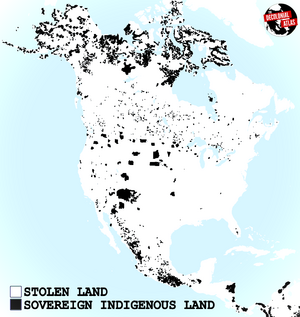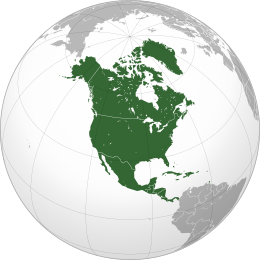More languages
More actions
North America, also known as Turtle Island,[1][2] is the northern part of the American continent. North America is located primarily within the Northern Hemisphere and Western Hemisphere. Depending on context, the term "North America" may include or exclude certain regions and countries, depending on geographical and sociocultural considerations. Geographically, North America is typically considered to extend from Canada in the north to Panama in the south. Due to cultural, historical, and linguistic factors, Mexico, together with Central and South American countries, also may be grouped under the name Latin America, with the United States of America and Canada being referred to as Anglo-America. Some limited definitions of North America refer only to the USA and Canada, and may or may not also include Mexico.[3]
Prior to European colonization, Native Americans, also known as First Nations people and American Indians, lived in autonomous nations throughout America. The economic and political structure of the various peoples of North America were complex, interconnected, and diverse, with some of the nations being nomadic or semi-nomadic hunter-gatherers while others built large urban complexes and engaged in agricultural pursuits. Nations and cultures across North America developed highly sophisticated social orders, built monumental urban centers, engaged in long-distance trade and agriculture on a large scale, inventing irrigation systems which still exist in parts of the United States in the present day (such as the U.S. Southwest, notably the area around Phoenix, Arizona).[4]
As Europeans began to colonize America, a long period of struggle, cultural disruption, and genocide ensued as the settler-colonial system was violently installed throughout the continent. As part of the establishment of settler-colonial society, enslaved peoples were brought mainly from Africa to work on the land seized by European settlers. To this day, settler-colonial regimes continue occupy the continent, while the native nations face marginalization on their own land. The African diaspora forcibly brought to the Americas by the settlers as well as the indigenous nations continue to struggle against the settler-states through a variety of methods. Decolonization is a pressing political consideration of the region, as in many other regions of the world.
The imperialist settler-state known as the United States of America currently occupies a large swath of North American territory and continues to be a leader in oppressing indigenous peoples worldwide, regarding the Western Hemisphere and the American region in particular as its "backyard", an attitude exemplified by the Monroe Doctrine.
History[edit | edit source]

The specifics of the original human migration to and throughout the Americas, including the exact dates and routes traveled, are subject to ongoing research and discussion. Agriculture was invented independently in two regions of North America: the Eastern Woodlands and Mesoamerica. In some regions, people managed habitats and plants using a variety of methods. The complex plant and habitat management practices engaged in by many of these societies blur the distinctions between hunter-gatherers and farmers to the extent that many anthropologists are no longer classifying certain American societies as "hunter-gatherers".[5]
The more southern cultural groups of North America were responsible for the domestication of many common crops now used around the world. As a result of the development of agriculture in the south, many notable innovations were made there. The Mayan culture was still present when the Spanish arrived in Central America, but political dominance in the area had shifted to the Aztec Empire further north.
Before contact with Europeans, the indigenous peoples of North America were divided into many different polities, from small bands of a few families to large empires. They lived in numerous culture areas, which roughly correspond to geographic and biological zones. Societies adapted their subsistence strategies to their homelands, and some societies were hunter-gatherers, some horticulturists, some agriculturalists, and many a mix of these. Native groups can also be classified by their language family. It is important to note that people with similar languages did not always share the same material culture, nor were they always allies.
Colonization[edit | edit source]

Lucas Vásquez de Ayllón established the first Spanish settlement in mainland North America in 1526 in what is now South Carolina. He brought 100 enslaved Africans and hundreds of settlers with him. The slaves and natives overthrew the settlers in 1527, with the Africans becoming the first non-native people to permanently live in North America.[6]
In 1562, France began its colonial empire by establishing Charles Fort in what is now South Carolina, followed by Fort Caroline in Florida two years later. English settlers built Fort Raleigh in 1584 and created their first permanent settlement at Jamestown in 1607. The English took over Fort Amsterdam from the Dutch in 1664.[7]
Upon the arrival of the Europeans, native peoples found their culture changed drastically. As such, their affiliation with political and cultural groups changed as well, several linguistic groups went extinct, and others changed quite quickly. The name and cultures that Europeans recorded for the natives were not necessarily the same as the ones they had used a few generations before, or the ones in use today. Rivalry between the European powers created a series of wars on the North American landmass that would have great impact on the development of the colonies. Territory often changed hands multiple times. Settlers used tactics of ethnic cleansing to continuously remove native people from their lands, opening the land to European settlement and use. The Indian Removal Act, which resulted in the Trail of Tears, and the California genocide, show some of the methods used by settlers to seize control of the land.
Slavery[edit | edit source]
The Atlantic slave trade, transatlantic slave trade, or Euro-American slave trade involved the transportation by slave traders of various enslaved African peoples, mainly to the Americas. People put into slavery were forced to work in many forms of labor throughout the Americas, agricultural production being a major sector in which their labor was used. Many forms of domination were used to keep the slavery system in place. Slavers engaged in a wide variety of physical and mental torture methods to control their slaves, clergy preached that slavery was the will of God, and scientists of the time sought to "prove" that Black people were less evolved, regarding them as a subspecies of the human race.[8]
References[edit | edit source]
- ↑ "Turtle Island." The Canadian Encyclopedia. Thecanadianencyclopedia.ca.
- ↑ Wilson, Kory, and Colleen Hodgson. 2018. “Introduction.” Opentextbc.ca. BCcampus. September 5, 2018.
- ↑ “North America | Countries, Regions, Map, Geography, & Facts” Encyclopædia Britannica.
- ↑ Mark, Joshua J. “Pre-Colonial North America.” World History Encyclopedia. May 6, 2021.
- ↑ “Origins of Agriculture - North America.” Encyclopædia Britannica.
- ↑ Nick Estes, et al. (2021). Red Nation Rising: 'Burn the Village' (p. 113). [PDF]
- ↑ David Vine (2020). The United States of War: 'Conquest' (p. 77). Oakland: University of California Press. ISBN 9780520972070 [LG]
- ↑ “Slavery in America - Timeline - Jim Crow Museum.” Ferris.edu.

